B.C.: There were three early Amerindian cultures. First, the Ciboney, about whom
little is known; experts date between 700 and 1000 BC. Exactly
where they came from is unknown.
The Arawaks and Caribs who
followed the Ciboney were in the late Stone Age.
1498: Columbus sighted the island
and called it Bellaforma. For a long period there was no recorded history of
Tobago.
1580: British seamen visited the
island and reported that it was uninhabited.
1596: Keymis visited the island
and found it deserted
|
1608: James I, King of England,
claimed Tobago.
1614: Spain tried to establish
trade with the island.
1627: Captain J. Gijsz,
on his return journey to Holland from Brazil, visited Tobago.
He reported
that the island was uninhabited and would be a good place to establish a
settlement
1628: Charles I, King of
England, granted Tobago to Philip, Earl of Montgomery, who later became Earl of
Pembroke.
1629: Jan de Moor, Burgomaster of
Flushing, sent an expedition of Dutchmen who made a settlement called New
Walcheren (probably Plymouth). Disease and Indians wiped it out.
|
|
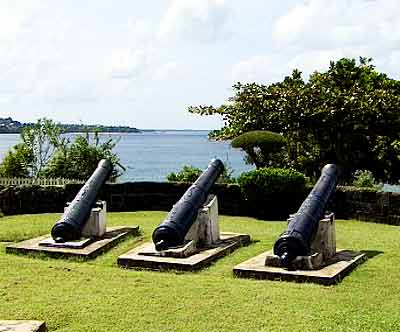 |
1632: Dutch settlers attacked by
Spaniards from Trinidad. Cornelis, Jan de Moor's son, was captured and the
settlers driven out.
1637: English Puritans from
Barbados attempted to settle. Most of them were killed by Indians. Those who
managed to escape sailed away to Providence Island, Bahamas.
1638: The Earl of Warwick who had
purchased Pembroke's rights sent an expedition which was attacked and destroyed
by Indians. James, Duke of Courland (Kurland, Latvia), said to be the godson of
James I, King of England, who had been granted the island by King Charles I of
England, sent an expedition to Tobago. The settlers were at peace with the
Indians but fever wiped out the settlement.
|
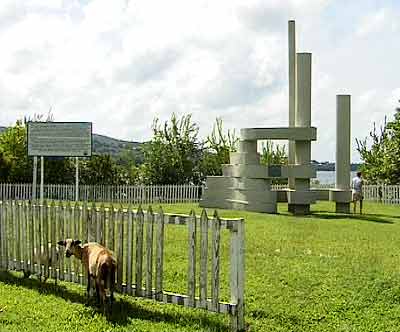 |
|
1642: James, Duke of Courland,
aided by the Dutch, sent another expedition. A settlement was made at Courland
Bay. Later in the same year, the Earl of Warwick made another settlement.
Tobacco and indigo were planted. Indians again routed the settlers; the few who
managed to excape went to Surinam (Dutch Guiana).
1647: Tobago offered for
sale in
England. There were no buyers.
1650: Courlanders driven out by
Indian; survivors went to Pomeron (British Guyana).
|
|
The Courland Monument |
1654: Third attempt to settle the
island made by the Duke of Courland. More than 100 families arrived from Europe.
Without modern financial conveniences, these families didn't have the option of
taking out
small business loans and were all forced to start from scratch and live off
of the land.
The Dutchman, Willem Mollens, took official possession of Tobago in the name of
the Duke and renamed the island "New Courland". In this year, Adriaen and
Cornelis Lampsins, heirs of the De Moores, attempted a settlement in another
part of the island, under Peter Becquard as Commander. He renamed the island
"New Walcheren". Tobago became divided into two parts. This led to a dispute
between Courlanders and Dutch settlers. The matter was reported to the States
General in Holland, who supported the Courlanders against their own countrymen.
Duke James became the undisputed master of the island. However, he was seized in
Europe by the King of Sweden and taken to Riga. Dutch planters in Tobago
surrounded the Courlanders who surrendered to them.
|
1659: Mollens, the Governor of
the Courland colony, is forced to leave the island.
1662: Dutch settlers now obtained
a
grant of Tobago from Louis XIV of France. The French West India Company
surrendered their rights and the French created the Lampsins "Barons of
Tobago".
1664: Charles II of England
re-granted Tobago to the Duke of Courland, who at this time did not attempt
another settlement.
1665: New Walcheren had between
1000 and 1500 colonists and 7000 slaves.
|
|
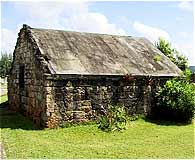 |
1666: Four English vessels under
the command of Captain Poyntz captured the Dutch settlement. He took 150
prisoners and left a small garrison which shortly afterwards was evicted by the
French from Grenada, who then abandoned the island.
1667: Treaty of Breda allows the
French to keep Tobago. The Dutch appointed Abel Tisso, a Frenchman, as Governor
to reform the settlement.
1672: The English, under Sir
Tobias Bridges, captured the Dutch Governor, took 400 prisoners, destroyed the
settlement and then abandoned the island.
1676: The Dutch began another
settlement with a large number of negroes captured from the French in Cayenne
and Marie Galante.
1677: In March, the Dutch Admiral
Binckes defeated the French Fleet in Roodklip Baai (Rockly Bay). Towards the end
of the year, the French returned, captured the Dutch Governor, destroyed the
settlement and then abandoned the island.
1678: The Duke of Courland tried
in vain to get
settlers for Tobago.(Flag below)
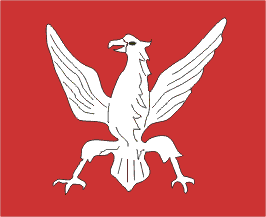 |
|
1679: By the treaty of Nimeguen,
Tobago was restored to the Dutch.
1680: The Duke of Courland again
attempted to settle in the island. He granted a title to some London merchants
headed by Captain John Poyntz. When all the arrangements had been made, the
Privy Council in London held up sailing pending negotiations for a Treaty.
1685: Publication of Poyntz's
pamphlet about Tobago.
1686: In spite of the fact that
the British Government had declared that the grant made to the Duke of Courland
was null and void, he made further attempts to settle the island. At about the
same time, English and French companies tried to establish themselves. |
1698: HMS Speedwell, with
soldiers on board, was sent from Barbados to suppress pirates who had
established themselves in Tobago. The British Government, on hearing that
preparations were being made for a settlement under the supervision of the Duke
of Courland to be held by Sir William Waller, issued orders to stop all vessels
leaving England for Tobago.
1699: Courland's grant again
declared null and void by the British Government. At the same time the right
of the British Crown to Tobago and St. Lucia was affirmed.
1702: Petitions from Captain
Poyntz and other made to the British Crown praying to be allowed to settle
Tobago, were refused. Further petitions refuses. The island then became a
no-man's-land.
1705: A French squadron used
Tobago as a base for attacking English West Indian island.
1714: Ayris, the Paramount
Indian Chief, was sent from Barbados to Tobago where he was made the Governor. In
1715, he appealed to the English Governor of Barbados for protection against
rebellious negroes. He was assured of British protection. Britain claimed
sovereignty against the French.
1719: Publication of
Defoe's "Robinson
Crusoe", Vol I and II.
1720: The Governor of Barbados
authorized to make grants of land in Tobago for the cultivation of cacao,
indigo, etc., but no sugar for this would be against the interest of Barbados.
HMS Winchelsea captured Captain Finn with a party of pirates on the island which
was now a pirate's nest.
1725: The Governor of Barbados
reported that the French were still claiming Tobago. The British government
authorized the Governor of Barbados to maintain England's right but to avoid a
clash with the French.
|
1731: Ferdinand, Duke of Courland,
supported by the King of Poland, tried to regain Tobago. In the same year he
offered to sell Tobago to the Swedes but the Swedish Ambassador in England, on
making enquiries regarding his rights to the island, was told that
he had no rights and at the same time warned the King of Sweden to stay
away from Tobago. |
|
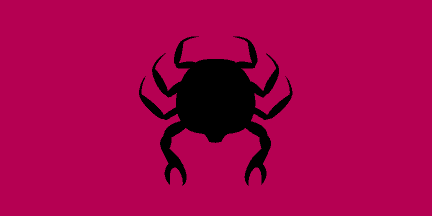 |
1732: The Swedes attempted a
settlement. They landed 25 families and slaves but were driven out by the
Indians.
1748: Marquis de Saylus, French
Governor of Martinique, attempted a settlement, landed troops and built a fort.
The British remonstrated to the French Government who disowned the Marquis' act.
English and French governments agreed to declare the island neutral. Subjects of
both nations left the island and the fort was destroyed.
1762: The English captured
Tobago. It was ceded to Britain by the Treaty of Paris in 1763.
1764: T. Alexander Brown
was
appointed Governor in November. The only inhabitants were a few Indians and
French turtlers. There was a lot of valuable land available. In December,
General Robert Melville was appointed Governor General of Grenada, Tobago, St.
Vincent, and Dominica. He resided in Grenada.
At this
time, Tobago was divided into parishes.
1768: In April, the first
session of Legislative Council and Assembly was held at Georgetown, Barbados Bay
(Studley Park) where the first town was established but never finished.
1769: Seat of the government
removed to Scarborough which was considered to be a more suitable place. A house
at Orange Hill was issued as the residence of the Lt. Governor.
1770: Uprising of slaves at
Queen's Bay. First shipment of sugar from Tobago left from Gedney Clarke's
estate in St Mary's Parish (Studley Park). Population: 209 white men, 3, 090
Negroes. John Paul (who
later changed his name to Jones) visited Tobago where he was brought before the
Court of Vice-Admiralty and changed with ill-treating his ship's carpenter.
(John Paul Jones was born in Scotland in 1747. His father was a gardener. He
died in poverty in Paris and was buried there. He is regarded as the founder of
the US Navy. His masthead is said to have been the first to have flown the
'Stars and Stripes').
1771: Two insurrections of
slaves. Both put down the militia.
1774: Another
uprising of
slaves.
1775: Cultivation of sugar cane
abandoned on account of devastation by millions of ants. Cotton was planted in
its place. Population about 2,300 whites, 1,050 free people of colour, 10,800
slaves.
1777: Governor Major William
Young killed in a duel with P.Franklyn. American privateers raided Tobago. They
came in armed boats and got away with whatever they could get.
1778: An American squadron tired
to capture Tobago but was driven off by HMS Yarmouth. It was at about this
time that guns were mounted on estates for their protection.
1779: Grenada captured by the
French. British Governor General taken prisoner.
1780: Population 11,087. Exports:
cotton - 2,619,000 lbs; indigo - 27,000 lbs.
1781: The first clergyman of the
Established Church began his work in Tobago. Church registers kept from this
date. In April the French captured Tobago. Lt. Governor Ferguson taken prisoner.
1782: Population 11,087. Exports:
cotton - 2, 619,000 lbs; indigo - 27,000 lbs. Cotton Hill (French Fort)
fortified. The French Government ordered all proprietors to produce titles to
their lands within a month. 1783: Tobago ceded to the French
by the Treaty of Versailles. Philbert de Blanchard appointed Governor by the
French. In this year, the total population of Trinidad was less than 800
inhabitants.
1784: Arthur Count Dillan, an
Irishman, appointed Governor by the French.
1785: Planters unable to produce
title deeds. Crown lands to be sold only to those of French nationality. King of
France demanded annual free gilts from the island. 336 persons who formerly
swore allegiance to Britain now swore featly to France hoping by doing this to retain
their lands.
1787: Scarborough renamed Port
Louis. The fort on Scarborough Hill called Fort Castries.
|
1789: First Moravian Mission
established.(The Moravian Church traces its roots back to very early reformist
movements in Bohemia and Moravia (today in the Czech Republic) linked to
Johann Hus. The movement, generally referred to as the Bohemian or
Moravian brothers, survived the initial attempts to have it destroyed by
the Catholic church. After the Reformation had swept large parts of
Europe, the Counter-Reformation nearly succeeded in destroying the
remnants of this brotherhood which scattered to remote areas throughout
Bohemia and Moravia.) |
|
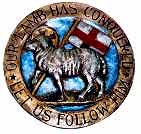 |
1790: Mutiny of French troops.
Scarborough destroyed by fire. In August, a hurricane passed over the islands
causing considerable damage.
1793: On April 15th, Tobago
captured by the British. The island then became a separate government with her
own governor, a legislative Council appointed by the British Crown and a
representative house termed the General Assembly.
1794: Militia formed.
1795: Corps of Black Jaegers
formed, made up of 100 trusted slaves under white officers for internal
protection. Proclamation requiring all male inhabitants to take oath of
allegiance to the British Crown. Almost all the French inhabitants refused, so
were regarded as prisoners of war.
1798: Sugar
once more in
cultivation, as cotton and indigo cultivation were not considered so important. At this
time Negroes were allowed to trade freely. A great number were thus able to buy
their freedom. 1800: Grave shortage of imported
food. Island's crops failed causing widespread alarm. People were unable to feed
themselves of their slaves. No Christmas supplies available. Population: 2,300
Europeans, 1,050 Free Colonists, 10,000 slaves. 106 estates.
1801: Threatened
uprising of
slaves averted by the prompt action of Brigadier General H.L. Carmichael, who on
hearing of the plot seized 30 ringleaders. One he hanged on the signal staff at
Fort King George, the body was lowered and raised 29 times. This put an end to
all ideas of insurrection.
1802: By the Treaty of Amiens,
the island was surrendered to the French. General Sabuguet was appointed
Governor. During his term of office the Council and General Assembly voted
unanimously in favour of Bonaparte being elected Consul for life. It was also
decided that the constitution and laws should not be changed.
1803: British troops landed at
Arnos Vale and marched to Mt. Grace. From there they were shown the way to the
fort by a slave, George Winchester, who was rewarded by being given his freedom
and £30 to set himself up in business. The French surrendered without
resistance. In July, a Proclamation was issued allowing imported provisions and
other goods to be brought in to Tobago in American vessels. 1805: Nelson in Caribbean waters
looking for French fleet. He anchored in Courland bay where he remained
overnight. Plans for defence of the island were drawn up.
1807: Abolition of the Slave
Trade in all British dominions. At the time there were 15,000 slaves in Tobago.
1812: An Indian, call Louis, with
his family of 200 persons were the only remaining settlers on the north coast.
1814: By the Treaty of Ghent, the
war between Great Britain and the United States came to an end. 1815: Tobago ceded to Great
Britain by the first Treaty of Paris.
1816: Tobago's motto, "Pulchrior
evenit" adopted. Act passed for the building of St. Andrew's Church, Scarborough.
The market place in Scarborough required for public purposes. All buildings
there removed.
1818: Society of Wesleyans
established a Mission. Spotted deer introduced from the Spanish Main.
1819: St. Andrew's Church in
Scarborough consecrated.
1821: Foundation stone of Court
House and Public Office laid at the Market Place. This building was considered
to be one of the best examples of Georgian architecture in the West Indies.
Recently alterations have ruined the character of the building which has lost
most of its original characteristics. 1822: Scarborough declared a Free
Port. Agriculture in a poor state.
1826: New Wesleyan Chapel opened
in Scarborough.
1828: New Government House at
Mt. William finished.
1833: Tobago ceased to form a
separate government and became part of the Windward Islands with a Governor
General in Barbados and a Lt. General in Tobago. Agricultural Society formed in
this year. 1834: Emancipation of slaves. The
Apprentice System, under which slaves were bound to their former masters for 4
to 6 years, came into force. All children under 6 years of age unconditionally
free. The transition period passed peacefully in Tobago. 11,589 slaves freed;
compensation of £233,875 paid to previous owners. The Scottish Presbyterian
Church made provision for a clergy man in the island. Majority of white
population Scottish. Medals presented by the Agricultural Society to persons
voted to have produced the best sugar.
1835: Obeah
(A form of witchcraft or black magic) being practiced in
secret but could not be repressed and persists even today. Presbyterian churches
being built. Schools erected and opened.
1836: Permission granted to
Apprentices to hold revels, dancing late into the night, because of unrest among
them.
1837: Court House at the disposal
of Presbyterian Church for Sunday service whilst church is being built. Colonial
Bank branch opened in Scarborough.
1838: Unconditional freedom
granted to all who had been made apprentices after the abolition of slavery.
Many left the land and became fishermen. There was discontent and a shortage of
labour. Labourers were not disposed to take possession of unoccupied land and
would not allow their children to cultivate the soil. This caused many estates
to go out of cultivation. Education considered necessary and schools were
opened.
1839: Crops poor during several
years.
1840: Branch of W.I. Bank opened
in Scarborough.
1841: Royal Mail Stream Packet
Co. began calling at Tobago.
1843: Lighthouse erected at
Bacolet Point. During the period of Apprenticeship, few marriages took place,
but now were now frequent and used as an occasion of festivity. In
an effort to improve agriculture, Mr. Cruikshank of Prospect Estate introduced
the Metayer System. This was a profit sharing system. It was adopted throughout
the colony. Later it was modified and applied to cacao as well as sugar
production.
1847: A disastrous hurricane preceded by earthquake and
accompanied by thunderstorms passed over the island. Private property, valued at
$150,000, destroyed. The British Government granted a loan of $50,000 for
sufferers.
1850: Exports: 47,730cwt sugar;
114,684gals rum, 3,255cwt molasses. Cultivation of cotton advocated. 1851: Population 14,378. In this
year, 292 liberated Africans sent from St.Helena by the British Government to
settle in Tobago.
1852: Introduction of Land Tax.
1854: British troops withdrawn
from Fort King George, the islanders left to make their own arrangements for
defence and the preservation of law and order. However, the British Government
promised to keep a Vessel of War within call in case it should be required.
Police Force augmented and armed Volunteer Corps established. Plot to destroy
Scarborough discovered. It was promoted by immigrant Negroes from Barbados.1855: Imperial (British) Customs
Officers replaced by Colonial Officers under the Treasurer. An Executive Privy
Council introduced, consisting of 1 member of the Legislative Council, 2 elected
members. Legislative Assembly appointed by Lt. Governor.
1856: First public hospital
opened.
1858: Tobago adopted the
Encumbered Estates Act of 1854. Commissioners were appointed in London for the
sale of lands by creditor or owner. From proceeds of the sale and equitable
distribution was made to all creditors. An entirely new grant, hereafter
unassailable, was issued for the property.
Estates passed to those with capital
to work them or who were prepared to sell in small lots.
1860: Authority of Imperial Post
Office Department vested in Executive Government of Tobago.
1861: Population: 15,410.
Exports: sugar -59,052cwt; rum - 109,047gals; molasses - 1,207cwt.
1862: 225 more liberated
Africans arrived from St.Helena to augment the labour force.
1865: Sale and export of cotton
to be regulated. This year, 23,195lbs were exported.
1867: Tax on dogs introduced,
causing riots.
1870: Italian Roman Catholic
Mission set up at Mason Hall.
1871: Franchise extended to $5.00
to holders of property.
1872: Concurrent Endowment Act
passed by which the Church of England ceased to be the established church of the
colony. Annual grants of money made to Anglican Church, United Brethren
(Moravians) and Wesleyans.
1874: Single Chamber Act passed
by which Legislative Assembly consisted of 6 nominated and 8 elected members.
Privy Council reduced to 2 members.
|
1875 - 1903
Colonial Flag
1876: Riots in Windward
districts.
1877: Under a new Constitution
Act, Tobago was administered as a Crown Colony and the elective principle
abolished. Last meeting of Privy Council held in December.
|
|
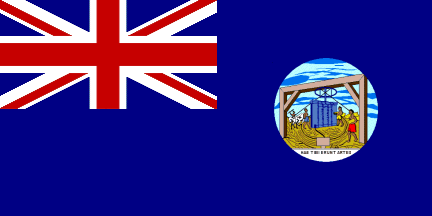 |
1880: British Government ceased
to provide salary for a Lt.Governor. The offices of Administrator and Colonial
Secretary combined. Population: 18,051. Exports: sugar - 65,467cwt; rum -
26,050gals; molasses - 7,780cwt.
1882: Labour very scarce. There
were 32 distilleries but only 17 working.
1883: Tobago had no public debt.
Agriculture Society held its first show - the opening day was declared a Public
Holiday. At this time two thirds of the island was covered by forest. A Royal
Commission (Crossman Commission) arrived from London. They were sent to the West
Indies to enquire into conditions in Tobago and the other islands.
1884: News was received that the
firm, Messrs. A.M.Gillespie & Co, in London, had stopped payment. For many years
this firm had carried on business in Tobago as commission Merchants and Ship
Owners. They virtually had the monopoly of agriculture and shipping interest,
owning about four fifths of the sugar estates. This brought about the financial
collapse of Tobago. Estates were sold at 10/-per acre. Peasants took advantage
of this, which left little labour for estates.
1885: The Royal Commission
recommended that Grenada, St. Vincent, St. Lucia and Tobago be made into one
colony, if acceptable to the majority of the inhabitants. This met with much
opposition so the matter was dropped. Later in the year, Barbados was made a
separate colony and the other islands became the Windward Group with a Governor
in Grenada. Each island retained its legislature presided over by a Resident
Administrator.
1888: By and Order in Council
dated October 20th, 1888, Tobago was made subordinate to Trinidad as from
January 1st, 1889 to be administered by a Resident Commissioner who was ex
officio a member of the Trinidad Legislative Council and appointed by the
Governor of Trinidad.
1890: Population of Tobago
18,353. Revenue: £8,695. Expenditure: £9,253. Imports: £23,403. Exports:
£19,371. Crops produced: sugar - 22,382cwt; rum - 3,432 gals; molasses -
7,360cwt; coconuts - 543,312; cacao - 31 bags.
1898: The island, broke and in
debt, becomes a Ward of Trinidad. "Tobago's humiliation was complete." (Eric
Williams: "History of the People of Trinidad and Tobago",p.150)
1899: Botanical Garden started.
Cultivation of cocoa began (Richmond).
|
1903 - 1974:
Colonial Flag
1908: Cocoa well established and
coconut palms beginning to replace the sugar cane. The first few telephones
installed.
1915: First motor cars on the
island.
1920: Riots, in sympathy with
those in Trinidad.
1921: Minor hurricane hits the
island and causes landslides.
1925: New Trinidad and Tobago
constitution establishes seven constituencies, one of which is Tobago. Bishop's
High School is opened. |
|
.jpg) |
1926: Water reservoir at the
fort built.
1927: First Cocoa Fermenting
Co-operative started (Pembroke).
1931: Lime Growers' Co-operative
formed. Sugar cane almost replaced. The Tobago Branch of the "Band of Mercy",
later to become the S.P.C.A., was formed.
1937: Riots in Trinidad and
Tobago. When all had quieted down in the island, a warship was sent and
scattered leaflets from its seaplane over Tobago.
1938: Royal Commission sent to
inquire into the conditions in British West Indies. The Tobago Chamber of
Commerce was inaugurated.
1940: Crown Point Airport
opened. Development and Welfare Organization for the B.W.I. set up.
1941: First community
centre
built (Plymouth) by voluntary labour.
1942: Radar station built by
U.S. Army near Charlotteville. B.W.I.A starts first commercial flights.
1943: Crown Point runway
extended.
1944: First bus company connects
all accessible parts of the island.
1945: Second Colonial
Development and Welfare Act passed, raising great hopes in Tobago.
1946: Universal adult suffrage
introduced.
1948: First nursery school
started (Black Rock).
1949: Excessive rainfall causes
severe damage in the northern part of the island.
1950: New constitution for
Trinidad and Tobago approved, giving the country more autonomy.
1952: Electricity installed in
Scarborough.
1953: Deep water harbour opened
on Scarborough waterfront.
1956: Tobago and Trinidad
resolve to partake in an independent Caribbean Federation. In Tobago,
introduction of free secondary education. Construction of north coast roads
begun.
1958: Trinidad and Tobago
partner of the West Indian Federation, keeping their own Governor.
1960: Ships, "Scarlet Ibis" and
"Birds of Paradise", start regular service to and from Port of Spain.
1962: End of the West Indies
Federation. Trinidad and Tobago becomes an "independent and unitary state"
within the British Commonwealth and under a Governor General representing the
Queen of England.
1963: Hurricane "Flora" destroys
many houses, estates and the rain forest, with a total loss of 17 lives (last
disastrous hurricane in 1847).
1967: Partnership of the country
in the Caribbean Free Trade Area (CARIFTA) and Caribbean Development Bank.
1969: Championship 18-hole golf
course opened at Mt.Irvine. Extensive housing developments all over the island.
1970: Riots caused by imported
Black Power Movement disturb the island's peace in April and result
mainly in more damage.
1972: Extension of the harbour
facilities in Scarborough.
Our grateful thanks to
www.flagspot.net for allowing us to use the images of flags on this page.